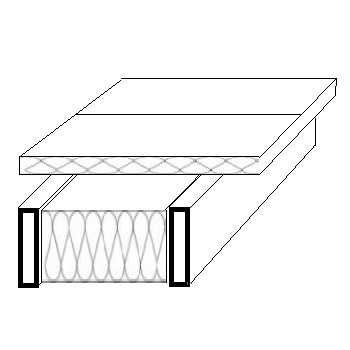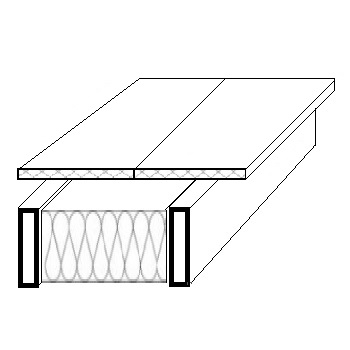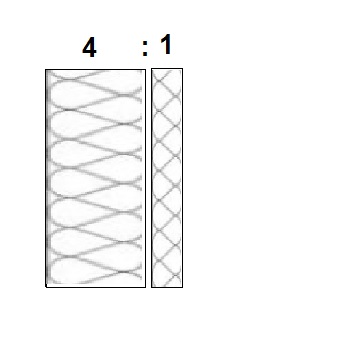
ONE OR TWO LAYERS OF INSULATION?*
The installation of thermal insulation must be carried out with precision. Incorrect installation can result in thermal bridges, which usually lead to moisture condensation and, consequently, the growth of mould, not to mention heat loss. To avoid this, it's best to install two layers of insulation. In this article, we will describe how to do this, what precautions to take, and when to perform this installation.
WHERE SHOULD I DOUBLE UP INSULATION?
As a general guideline, it's advisable to install double layers of thermal insulation throughout your house. Nevertheless, this may not be feasible in all areas due to space limitations. Typically, it's not practical to add two layers of insulation within the walls of your home.
The most common areas where double insulation layers are employed include the attic (the ceiling that separates the living space from the attic), a pitched roof (the space between the rafters), a flat roof (the area between the floor joists) as well as in suspended ‘Armstrong’ ceilings.
CAN YOU LAY INSULATION OVER INSULATION? STACKING INSULATION ON TOP OF INSULATION.
Adding a new layer of insulation over older insulation can be a good idea if the old insulation is dry and in good condition. However, there are circumstances where you should avoid installing new insulation over the existing layer. Here are some reasons when:
- Old Insulation is falling apart.
- Old Insulation has fire damage.
- Old Insulation has evidence of rodent damage.
- Old Insulation has hazardous materials like asbestos.
- Old Insulation has been squashed by storage boards.
- Old Insulation have got dust that’s been filtered through.
In these cases, it is generally recommended to remove the old insulation before adding new insulation to ensure proper performance.
SHOULD I DOUBLE UP MY LOFT INSULATION?
The most common situation for adding an extra layer of thermal insulation is in the attic floor. If your loft is not used for storage purposes, doubling the insulation layers is highly recommended.
By doubling the insulation layers in your loft, you increase its R-value, which in turn reduces its U-value (lower U-value is better). This results in better insulation and improved energy efficiency for your living space.
Installing multi-layer insulation in this scenario is relatively straightforward and doesn't require advanced skills.
When insulating a loft, many people choose to double up the insulation layers in the following manner: the first layer, which is thicker, is used to fill the gaps between the floor joists, while the second layer, which is thinner, covers the entire floor surface, including both the joists and the previously installed first layer of insulation. The second layer of insulation is then laid perpendicular to the attic floor joists to avoid thermal bridges.

In some cases, people opt to install the second layer of insulation in a parallel manner but shifted by 50% of the width of the first layer of insulation. However, this method is less commonly used due to the higher likelihood of compression at the central point of the insulation.

WHY FIST LAYER OF INSULATION SHOULD BE THICKER THAN SECOND LAYER?
When installing two layers of insulation, it's essential to remember that the first layer (on the cold side) should always be thicker than the second layer (on the warm side).
The reason for placing the thicker insulation layer on the colder side is because materials with higher R-values are better at blocking the transfer of cold. Meanwhile, the second, thinner layer of insulation typically acts as a safeguard against any mistakes that might have occurred during the installation of the first layer.
These errors could include incomplete cuts in the insulation, uneven joists or rafters, or even compression of the initial insulation layer.
The thinner layer of insulation should be chosen with a consideration of a 1:4 ratio, meaning that if you install the first layer of insulation with a thickness of 200mm, the second layer should be approximately 50mm thick.

This ratio helps ensure proper insulation and minimises the risk of compression or other installation issues in the first layer.
Another scenario where it's essential to install the thicker insulation as the first layer is in the case of insulating the floor beneath concrete slabs. As it's easy to notice, the thicker insulation layer is always installed on the ground first because its compressive strength is significantly higher than that of the thinner layer. Additionally, having a lower U-value for the thicker product maximises energy savings in the long run.
Now, imagine a scenario where we install the thinner insulation on the side exposed to cold weather, facing the exterior. In such a situation, the cold air can quickly pass through the thin insulation layer, making it ineffective and redundant. This results in a loss of about 25% of the insulation's effectiveness, not to mention the extra expenses incurred when purchasing the insulation.

SECOND LAYER OF INSULATION. WHAT DOES IT DO ?
The second layer of insulation in a home serves several important functions:
- It corrects any construction errors that may have occurred during the installation of the first insulation layer, ensuring a more consistent and effective insulation barrier.
- It enhances the overall thermal resistance (R-value) of the entire assembly, reducing its U-value, which indicates better insulation performance.
- It minimises the risk of thermal bridges, virtually eliminating their formation when installed properly.
- It ensures uniform insulation coverage across the entire surface area, including structural elements like joists or rafters, reducing the risk of heat loss.
- In some cases, the second layer can also serve as a vapour barrier or provide additional moisture control, helping to prevent condensation issues within the building envelope.
Overall, the second layer of insulation plays a crucial role in improving insulation performance, reducing heat loss, and maintaining a comfortable and energy-efficient living space.
CAN YOU DOUBLE UP ON ROOF INSULATION?
Enhancing roof insulation by adding a second layer significantly boosts the R-value, making it a worthwhile strategy, particularly when striving to meet more stringent insulation standards. However, when increasing the insulation thickness on the roof, it's essential to account for the potential additional weight load and the risk of condensation-related issues.
Surprisingly, about 8 out of every 50 of our customers opt for a double layer of roof insulation to trim their gas bills. Given that the roof is a primary source of heat loss in buildings, doubling up on insulation in this area comes highly recommended.
If your roof has insulation between the rafters, it's considered good practice, according to current standards, to double its thickness to achieve a U-value of 0.16W/m2K.
By adding a second layer of insulation, you can raise the roof's R-value from a range of approximately R-4.54m²K/W to R-7.35m²K/W, which aligns with the requirements set by Building Regulations in the UK. This ensures improved thermal performance and compliance with energy efficiency standards.
CAN YOU PUT TWO LAYERS OF CELOTEX TOGETHER?
Celotex is indeed one of the most popular and recognized insulation products in the UK. It is commonly used for insulating roofs, walls, and floors in various construction projects.
If you need to increase insulation thickness or achieve a higher R-value, you can stack two sheets of Celotex insulation on top of each other. Celotex rigid boards are typically covered with aluminium foil on both sides. Therefore, when you install two layers of Celotex together, you effectively create a total of four layers of aluminium foil insulation: two layers sandwiched together, one on the cold side, and one on the warm side of the building. This additional foil layer can help improve thermal performance and reduce heat transfer.
CONCLUSION
In summary, increasing insulation thickness makes sense, especially in light of the ever-stricter Building Regulations. Doubling the insulation thickness completely eliminates the possibility of thermal bridges, enhances the R-value, and rectifies any installation errors that may have occurred during the installation of the first layer.
It's crucial to remember the 1:4 ratio, meaning that the thicker insulation should be installed first, followed by a thinner layer with a thickness approximately one-fourth of the thicker layer. This approach ensures that the insulation works effectively to provide optimal thermal performance and energy efficiency in construction projects.
Related articles:
HOW TO PROPERLY INSTALL INSULATION BETWEEN RAFTERS: A STEP-BY-STEP GUIDE
VALUABLE TIPS FOR INSULATING A PITCHED ROOF BETWEEN RAFTERS
INSULATING AN OLD STONE HOUSE: FINDING THE PERFECT BALANCE
INSULATION TIPS: AVOIDING COMMON MISTAKES FOR A MORE ENERGY-EFFICIENT HOME
STEP-BY-STEP GUIDE: HOW TO INSTALL CELOTEX BOARD BETWEEN FLOOR JOISTS
COMPARING ALTERNATIVES TO CELOTEX: ROCKWOOL, KINGSPAN, EPS, AND XPS POLYSTYRENE
WHAT IS THE NEWEST FUTURE INSULATION?
WHAT CAN GO WRONG WITH INSULATION? COMMON ISSUES AND SOLUTIONS
*All the information provided in the content published on Insulationgo blog is for informational and educational purposes only. Insulationgo LTD makes every effort to ensure the accuracy and timeliness of the content, but we do not assume any responsibility for any errors or omissions.
The information presented on this blog should not be considered as professional advice or a substitute for consulting relevant experts. Before making any purchase decisions or taking action based on the information presented here, it is strongly recommended to contact the product manufacturer directly to verify the details and ensure its suitability for your specific needs.
Any descriptions, drawings, photographs, data, proportions, weights, measured values etc. given herein may change without prior notice and do not constitute the agreed contractual quality of the products. It is the responsibility of the recipient of all products to ensure that any proprietary rights and existing laws and legislation are observed.
By using this blog, you acknowledge and agree that Insulationgo LTD shall not be held liable for any damages, losses, or inconveniences arising from the use or reliance on the information provided herein. This limitation of liability applies to all users of the blog, including but not limited to visitors, readers, and subscribers.










































































































